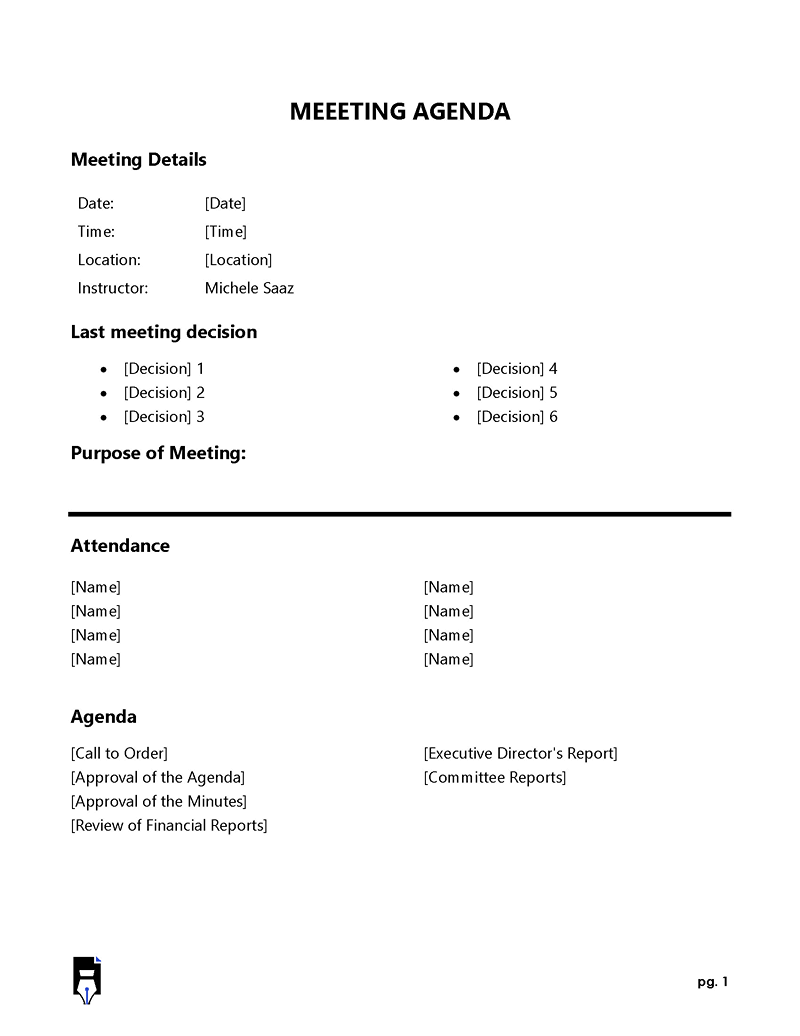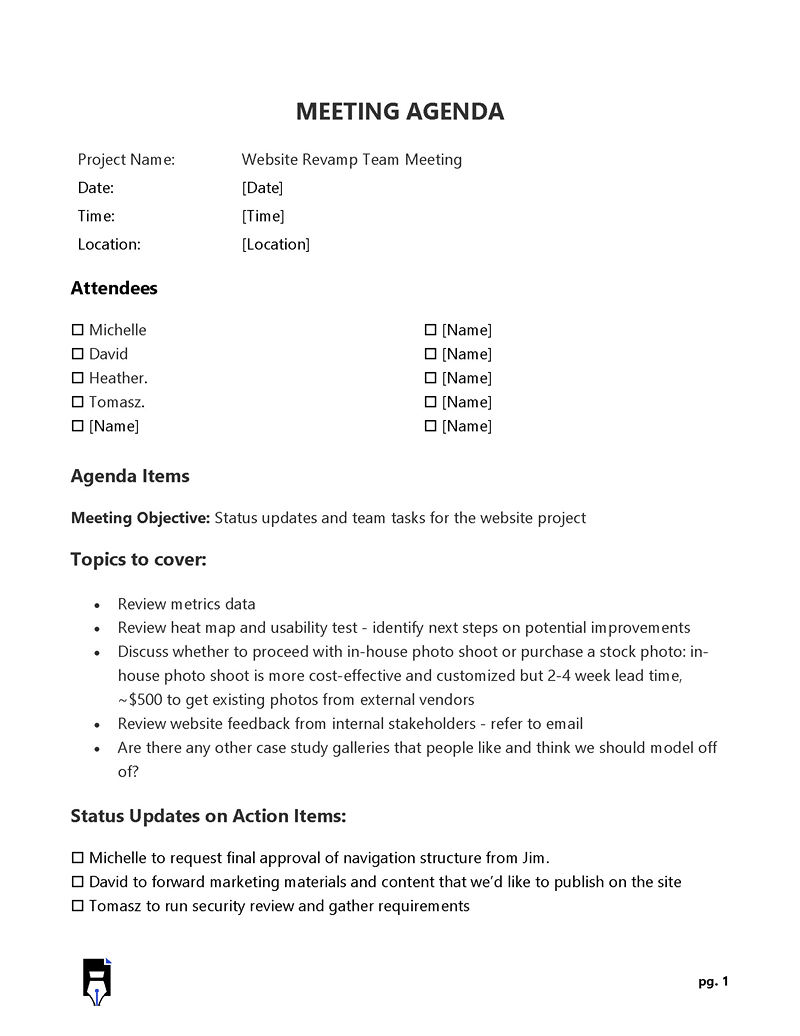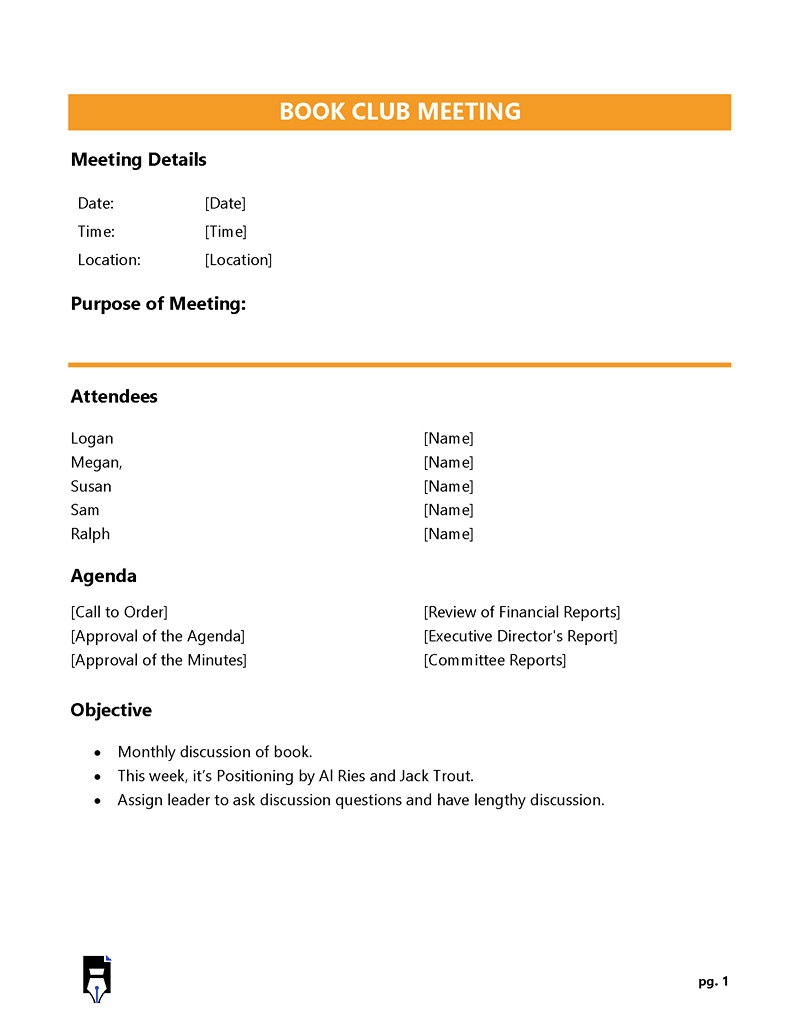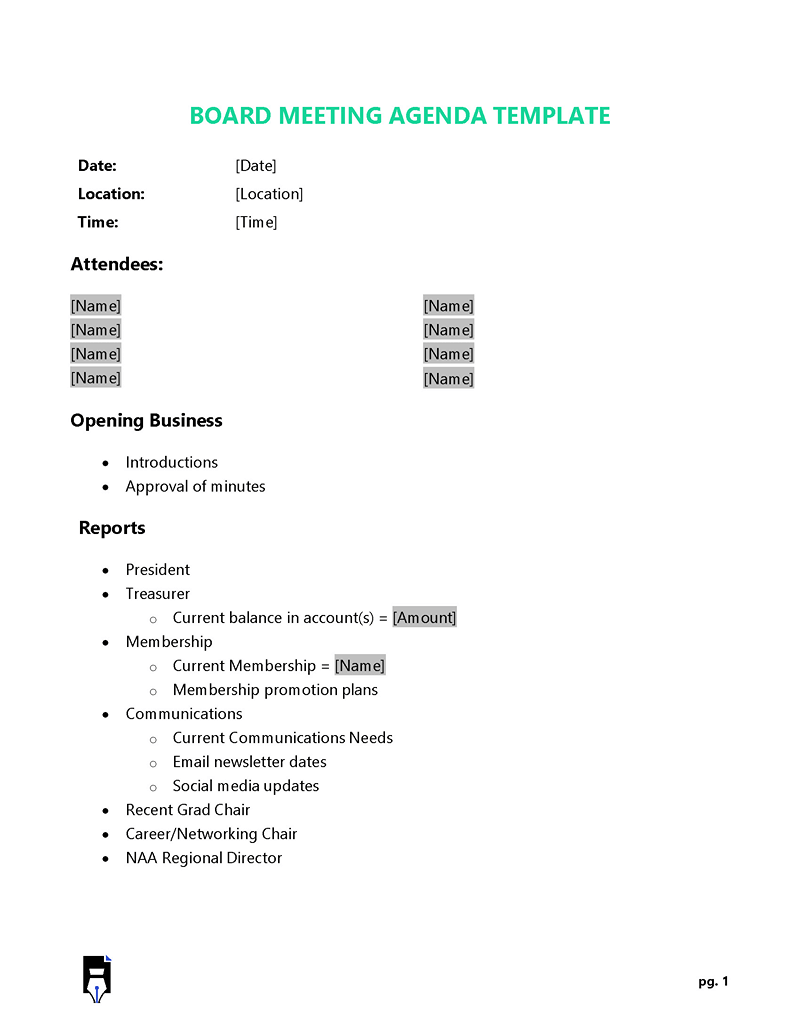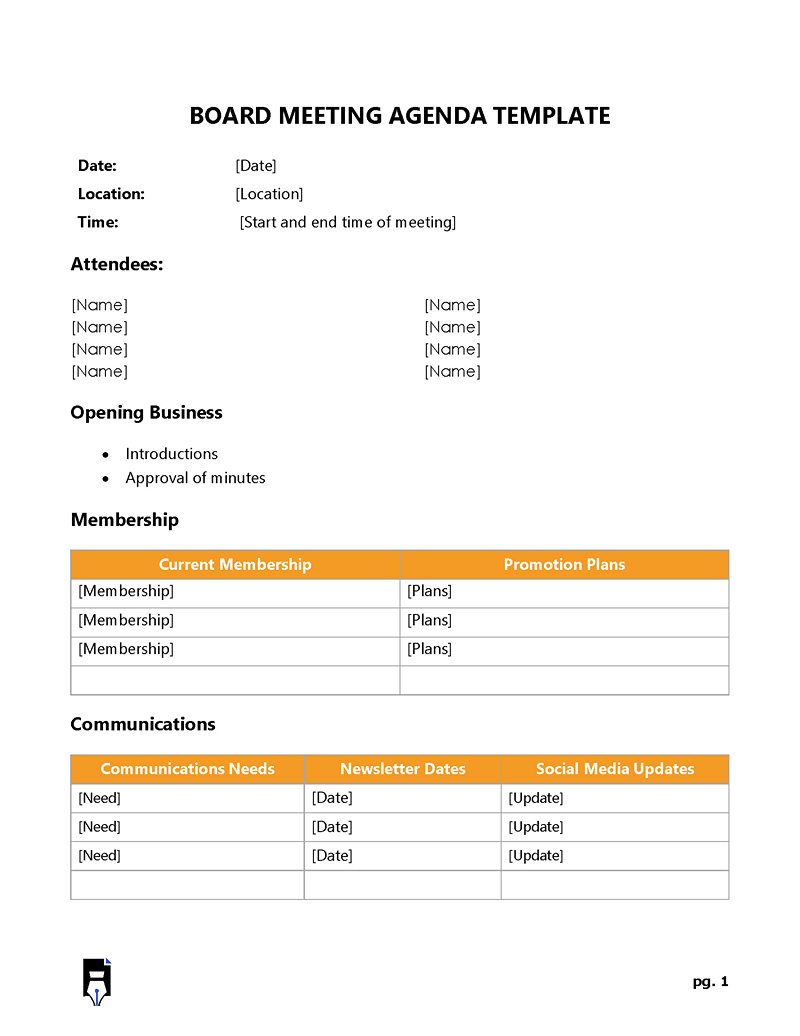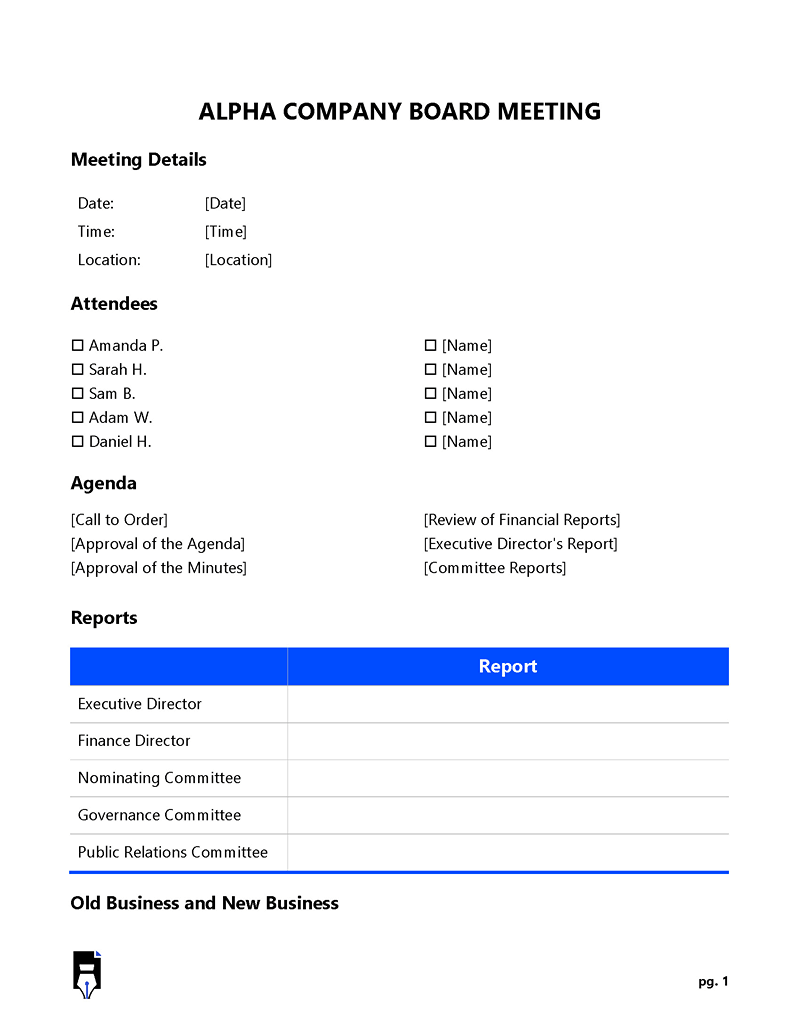An agenda for a meeting is a document given to all attendees before the meeting begins with a list of what will be discussed, who will discuss them, in which order, and for how long.
A meeting agenda lists the various discussion points and provides an overview of what will happen during the meeting, ensuring everything flows optimally and clearly.
An agenda also referred to as an order of business or meeting timetable, is a list of topics to be discussed and actions to be taken during a meeting. Without it, the meeting will likely go off-topic or take much longer to begin or end.
This article will break down everything, including who prepares the meeting agenda, why it is prepared, the different parts of it, and best practices to consider when preparing it. This article will also provide free downloadable templates to prepare your meeting agenda.
Basic Meeting Agenda Templates
As the meeting facilitator, if you are tasked with creating a meeting agenda, it is crucial to ensure that the agenda contains all the key elements to ensure that the meeting runs smoothly. Consider using a premade agenda template to avoid leaving out any critical elements. With a template, you only have to make minor changes and edits to have a professional-looking meeting agenda. We have provided free downloadable templates that you can download and use for all your meetings.
Who Prepares an Agenda?
A meeting agenda is usually prepared by the person that coordinates the meeting. This may be the meeting’s chairperson or a person who has been designated as a facilitator. The individual tasked with preparing the meeting agenda may be chosen because of their knowledge of a given topic to be discussed or because they have gathered all their facts and figures for each topic. Before preparing the contents, the meeting facilitator will, in most cases, consult the meeting attendees to find out what to include.
Reasons to Use a Meeting Agenda
A meeting agenda is a critical tool for efficient and effective meetings. An influential meeting agenda will give attendees a sense of order, increase attendance and productivity and help everyone keep track of what is supposed to happen during the meeting. On the other hand, organizing a meeting without an agenda can be time-wasting and extremely difficult, primarily if the attendees have never worked together.
Some of the key reasons why a meeting agenda should be used include the following:
Bring people together
It effectively brings people together and ensures everyone has a set role in the meeting. This helps in creating a sense of unity, and it also helps in creating an environment where everyone feels valued and welcomed, thereby encouraging participation and productivity. When preparing for the meeting, consider offering coffee, snacks, or other breakfast items to ensure that the meeting attendees are active and motivated during the meeting.
Stick to relevant matters
A well-crafted meeting agenda should ensure that meeting topics are limited and only relevant issues are discussed. Furthermore, by ensuring that only relevant issues are discussed, meetings can save a lot of time, allowing more time for other discussions that need to be held. The meeting will be concise and to the point by discussing relevant issues only. Do not allow the meeting to go on without discussing relevant issues, as this will make the meeting lose direction, and the audience may be disengaged.
Keep everyone focused
Without it, attendees may not know what to focus on and what to discuss during the meeting. This makes it difficult for the meeting to be productive, and attendees may lose track of the topic they were supposed to discuss while slowly drifting off topic completely. They ensure that all attendees stay focused on the topic, thus delivering maximum productivity from everyone at the meeting.
Help to set clear expectations
It is imperative to set clear boundaries and expectations on what to discuss and how it is done during a meeting. An agenda acts as a guide for all the topics to be discussed, the order of delivery, and how long each topic will be discussed. It also acts as a guide for updating everyone on the status of discussions in case there are any changes. Clear boundaries and expectations help prevent miscommunications leading to mistakes or misunderstandings.
Foster communication
It allows everyone at the meeting to communicate and share information effortlessly. By clearly laying down communication lines, it helps in keeping discussions focused and relevant during the meeting. With everyone given a chance to communicate, everyone at the meeting will feel empowered. This will also make them more likely to speak up and share their ideas and concerns, thereby improving the quality of the conversation and overall effectiveness.
Eliminate excuses
With a clear communication line and expectations/objectives, meeting attendees are less likely to make excuses for missing the meeting and not coming prepared. They will also be more willing to communicate with others about what they can do to help with the issues being discussed or what they think will be a productive discussion during the meeting. If you are hosting a virtual meeting, it is vital to use a meeting agenda to ensure that all the participants are well-prepared and ready to participate.
Manage meeting time
It can help manage the time spent during a meeting. With it, the attendees can see how much time each topic is expected to take, allowing them to spend more time on the most critical and productive topics. This helps ensure that everybody gets the time they need while ensuring that nothing is overrun.
In addition, by knowing every topic that will be discussed, you will be able to plan your next meeting accordingly, which will help you to avoid any last-minute rush. You will also be able to schedule your time in between meetings to keep employees productive, especially if the meeting is overly long.
Focus on outcomes
It provides a list of outcomes that are expected as a result of various discussions during the meeting. This helps ensure everyone at the meeting is clear on what they need to achieve at the end of each discussion. By clearly stating each outcome and ensuring everyone knows what to expect, meetings will be able to deliver and provide concrete actions and results, thereby delivering more value and utility to all attendees.
Parts of a Meeting Agenda
When preparing an agenda, it is vital to ensure it is thorough and well-organized. Therefore, it is essential to ensure that you are familiar with the different components of an agenda and how to create a well-organized, detailed, and complete agenda.
Below are some of the critical components that your meeting agenda should include:
Meeting type
It is vital to state the meeting you are hosting and the purpose you hope to achieve at the meeting. The purpose of your meeting will determine the type of agenda you should use; hence, it is crucial to ensure that it is clear and concise. Clearly defining the meeting type will make it easier to identify your meeting attendees. It will also provide direction regarding what and how it will be discussed.
Location and date
Just like you need to define the purpose of your meeting, you also need to define the location and date of your meeting clearly. This is important, especially if you want the meeting to be held in a specific room and at a particular time. Again, this will help establish an efficient and effective agenda that allows everyone to give their input effectively.
Names of the attendees
The names of all the participants in your meeting should be indicated on the agenda. By including the names of participants, you allow everyone to prepare and participate effectively. You can also improve the quality of communication by ensuring that all participants are given sufficient time to prepare for their input.
Purpose of the meeting
It should include a summary of the purpose of your meeting. This will help the attendees understand what will be achieved at the meeting. The purpose of the meeting will also ensure everyone has a clear understanding of the issues and that they have the right resources to help them make informed decisions. By defining the purpose of the meeting, you also facilitate a more productive and focused discussion that allows everyone to share their input and arrive at a clear decision.
Meeting duration
It is essential to include the duration of the meeting on the agenda. This will help you determine whether all the relevant and required topics will be covered during the meeting and whether sufficient time has been allocated for each topic. It will also help you inform people how long they have to prepare their input and effectively plan their time during the meeting.
Meeting topics
The agenda should include the topics that will be discussed during the meeting. It is important to highlight these so that all meeting participants understand what will be discussed and can plan their input accordingly. It is essential to organize your agenda in a clear, concise, and logical sequence that allows for effective communication. Including the topics that will be discussed on the agenda allows participants to identify which areas they can contribute and what is expected from them.
Time allocated for each topic
To ensure that the meeting is managed effectively, it is important to include how much time will be spent discussing each topic on the agenda. This will help you establish whether you can discuss all the topics in the limited time frame that you may have. In addition, when preparing the meeting agenda, allocate different levels of importance and urgency to each topic. This will help you to ensure that the most important topics have adequate time allocated to them and that less critical issues are not given more time than they need.
List of necessary documents
If you have decided to use a formal agenda, it is essential to include the documents required for the meeting. This will help you avoid any last-minute rush and inform all participants of what they need in terms of documents to participate effectively in your meeting.
Conclusion/summary
The agenda needs to end with a conclusion. Finally, the agenda should include the actions and decisions taken at the meeting. This will help you determine whether all participants have come up with an action plan that enables them to perform their duties effectively. It will also help ensure that everyone knows what they are expected to do after the meeting. The summary will also help everyone understand what they can expect from others, thereby avoiding confusion and promoting effective teamwork.
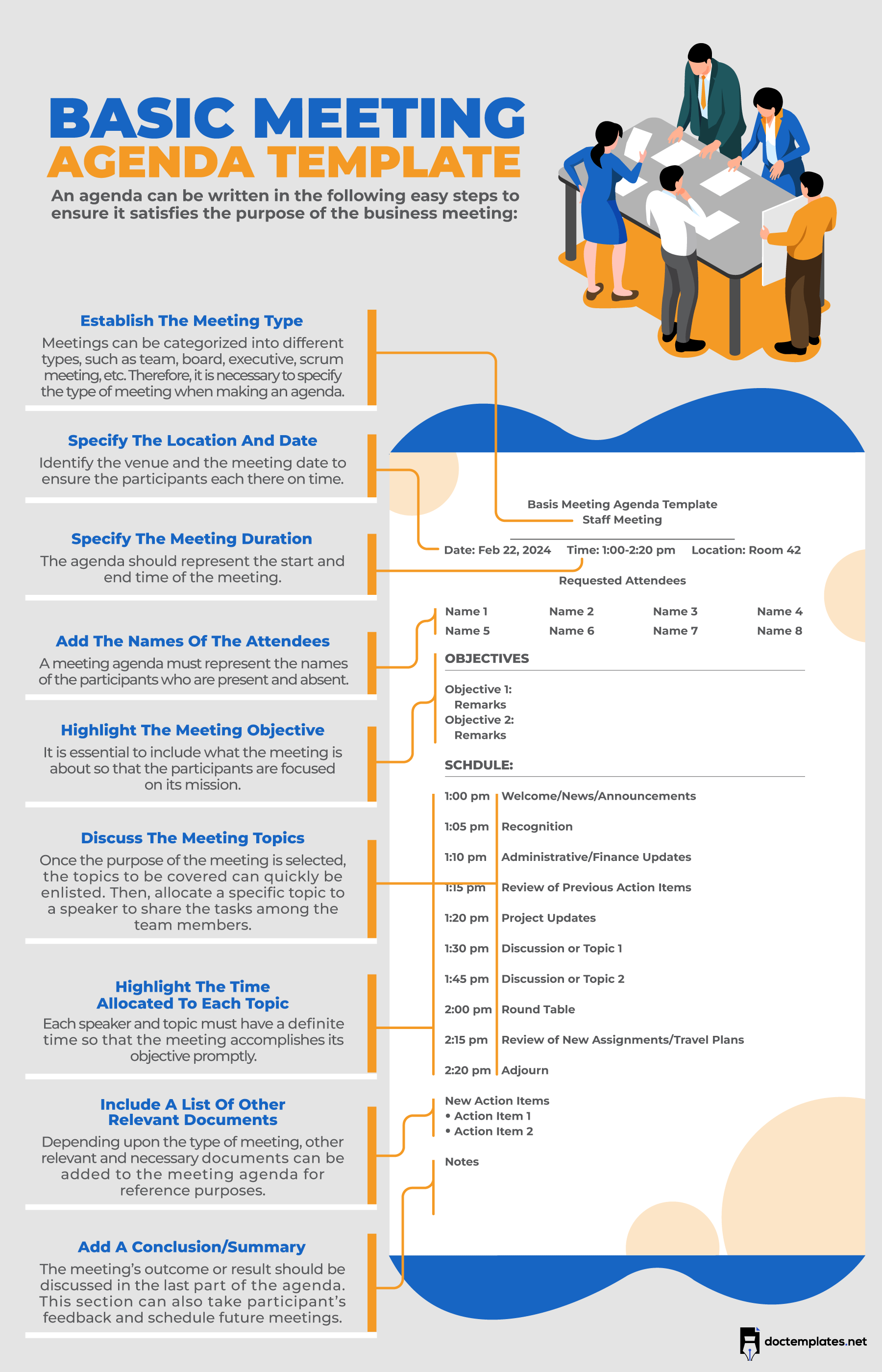
Best Practices to Consider
Here are some of the best practices to consider when preparing your team meeting agenda:
Be flexible
It is vital to ensure that your meeting agenda is flexible. Every meeting needs different inputs, so a time slot allocation may not be optimum for all meetings. Also, as meetings involve not only a limited number of attendees but also different topics, it is essential to ensure that the timeline flexibility allows you to discuss all the topics that need to be discussed efficiently.
Prepare the agenda ahead of time
The agenda should be prepared well in advance and distributed to all the participants before the meeting day. This will allow everyone to prepare for the meeting and get the necessary documents/materials/data in time.
Share responsibilities among the team members
It is essential to share the responsibility of preparing the agenda with your team members. This will help you ensure that all the required items are included and allow everyone to contribute to the agenda and help prepare for the meeting.
Start on time
It is important to start on time for every meeting. This will allow you to stick to and finish the meeting on time. If you are late for a meeting, inform your attendees beforehand so they can manage their schedule accordingly.
Include everyone
It is crucial to ensure everyone is included in the meeting rather than excluding some team members. This will help you avoid assumptions, increase team unity and allow all team members to contribute their input to the meeting.
Frequently Asked Questions
How does an agenda impact a meeting?
A well-structured agenda will help an organizer stay on track and help attendees understand what will happen at a meeting and how long it should take.
What would happen if there were no meeting agendas?
Meeting agendas play a vital role in the success of any meeting. They set a clear theme for the discussion, outline the topics to be covered, and provide an overview of what will happen at each meeting stage. Without an agenda, a meeting can quickly lose its focus and turn into an unstructured discussion.
What terms are commonly used in preparing and using an agenda?
Specific terms are used when preparing and using an agenda. Some of them are:
Action items- these are items that require a planned action or response.
Attendees – these are the committee members attending the meeting. Other commonly used terms include chairperson, minutes, meeting, etc.
